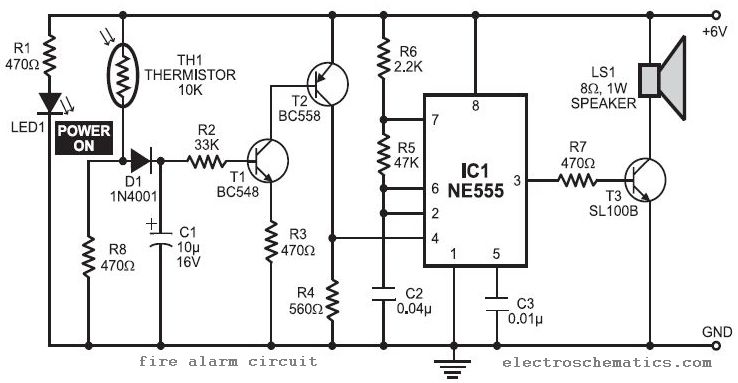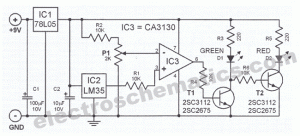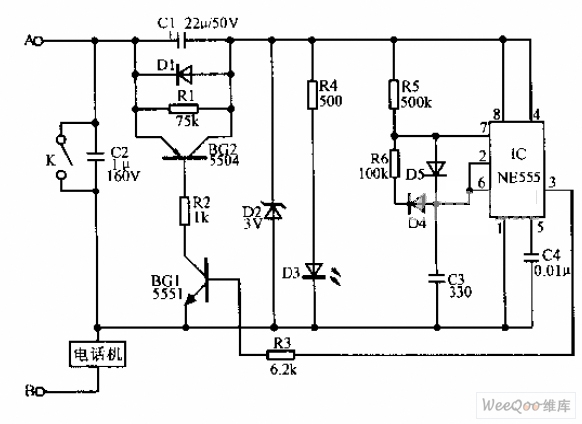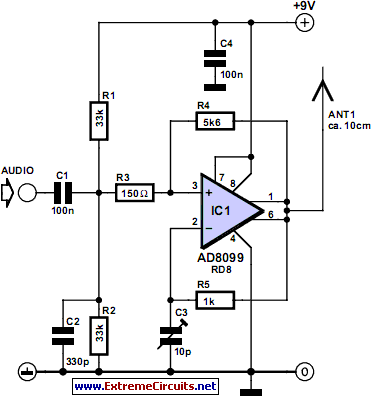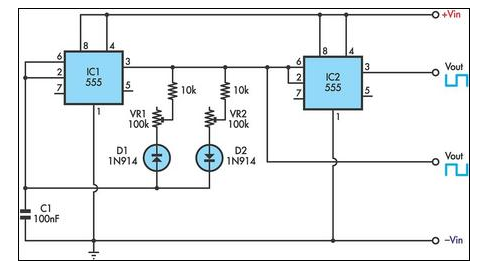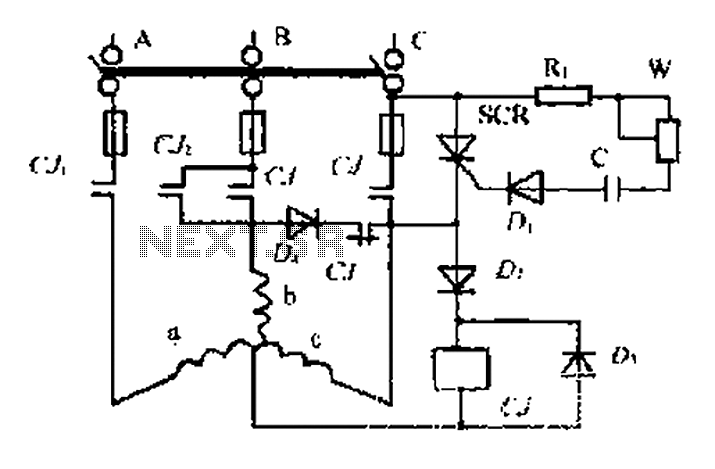
Remote tracking circuit schematics
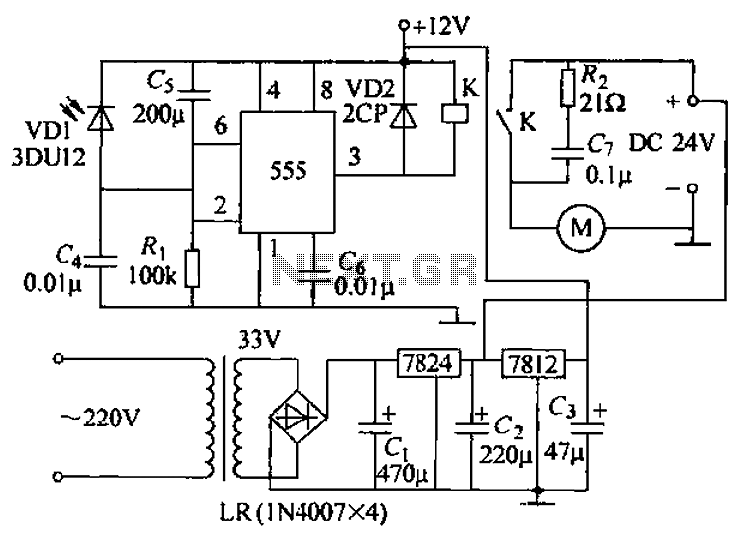
The circuit consists of two main components: (1) a power supply circuit featuring a transformer (T) that steps down AC 220V to 33V, followed by a full-wave rectifier, a filter, and a three-terminal regulator that outputs +24V. This circuit also provides power to the control circuitry. Additionally, it can utilize 24V AC. The photodiode control circuit, often associated with electrical control circuits, is made up of various components. The schematic illustrates a practical application for solar water heaters equipped with automatic tracking and remote control. The photodiode (VD1) is mounted in a cylindrical housing to receive directional light, allowing it to detect sunlight with a precision of 2 degrees ahead of the solar energy water heater. The 555 timer functions as a comparator with a time lag. When direct sunlight strikes the photodiode (3DU12), its resistance decreases, causing an increase in current. This leads the 555 output to go low, activating relay J, which connects the normally open contacts to power the electric motor. The solar energy is then harnessed to drive a reduction gear motor for operational efficiency. Conversely, when the sunlight on VD1 diminishes, the 555 output goes high, deactivating relay J and cutting off the power supply to the motor, thereby halting its operation. This mechanism ensures that the solar hot water system remains aligned with the sun, optimizing energy capture.
The circuit design integrates a transformer rated for 220V AC input, which steps down the voltage to 33V AC. This lower voltage is then rectified using a full-wave rectifier configuration, which typically consists of four diodes arranged in a bridge configuration to convert the AC voltage to DC. Following this, a filtering capacitor smooths the rectified voltage, minimizing ripple and providing a stable DC output. The three-terminal regulator is employed to further regulate the voltage down to 24V DC, suitable for powering the control circuitry and other components.
In the control circuit, the 555 timer is configured in astable or monostable mode, depending on the desired functionality. It operates by comparing the voltage from the photodiode with a reference voltage. The photodiode, when exposed to sunlight, generates a current that inversely correlates with its resistance. This behavior is critical for the operation of the system, as it ensures that the control logic reacts appropriately to changes in light intensity.
The relay J is a crucial component in this circuit, allowing for the switching of higher power loads, such as the motor driving the solar water heater. The normally open configuration of the relay ensures that the motor is only powered when there is sufficient sunlight detected by the photodiode. The reduction gear motor is selected to provide the necessary torque and speed for the application, ensuring efficient tracking of the sun.
This automatic tracking system enhances the efficiency of solar water heating by ensuring optimal orientation towards the sun throughout the day, maximizing thermal energy absorption. The overall design demonstrates a practical application of electronic components in renewable energy systems, showcasing the integration of power supply, control logic, and mechanical actuation to achieve a functional and efficient solar energy solution. Circuit consists of two parts, (1) the power supply circuit via the transformer T, AC 220V down to 33V, full wave rectifier, filter, three-terminal regulator outputs + 24V and - lzv to the control circuitry. Which can also be used - 24V AC 24V. (Z) photodiode control circuit 555 is also often associated with electrical control circuit composed of a variety binding way, figure gives a practical solar water heaters solar automatic tracking remote control. Photodiode VD1 mounted in a cylinder directional light received than too light direction by 2 degrees ahead of solar energy water heater, 555 as the lag than comparator work.
When direct sunlight to photodiode VD1 (3DU12), its resistance drops, the current increases, the 555 ended output low, the relay J pull, normally open contacts connected to electric machine power, solar energy through a reduction gear motor drive food Shun hour operation. When irradiated with sunlight VD1 diminished, 555 output high, the relay J normally open electric shock off, cutting electrode circuit power supply, the motor stops.
Thus, the solar hot water is always followed by the sun, called the sun go I can go chasing the direct sunlight, the light to achieve the best state.
The circuit design integrates a transformer rated for 220V AC input, which steps down the voltage to 33V AC. This lower voltage is then rectified using a full-wave rectifier configuration, which typically consists of four diodes arranged in a bridge configuration to convert the AC voltage to DC. Following this, a filtering capacitor smooths the rectified voltage, minimizing ripple and providing a stable DC output. The three-terminal regulator is employed to further regulate the voltage down to 24V DC, suitable for powering the control circuitry and other components.
In the control circuit, the 555 timer is configured in astable or monostable mode, depending on the desired functionality. It operates by comparing the voltage from the photodiode with a reference voltage. The photodiode, when exposed to sunlight, generates a current that inversely correlates with its resistance. This behavior is critical for the operation of the system, as it ensures that the control logic reacts appropriately to changes in light intensity.
The relay J is a crucial component in this circuit, allowing for the switching of higher power loads, such as the motor driving the solar water heater. The normally open configuration of the relay ensures that the motor is only powered when there is sufficient sunlight detected by the photodiode. The reduction gear motor is selected to provide the necessary torque and speed for the application, ensuring efficient tracking of the sun.
This automatic tracking system enhances the efficiency of solar water heating by ensuring optimal orientation towards the sun throughout the day, maximizing thermal energy absorption. The overall design demonstrates a practical application of electronic components in renewable energy systems, showcasing the integration of power supply, control logic, and mechanical actuation to achieve a functional and efficient solar energy solution. Circuit consists of two parts, (1) the power supply circuit via the transformer T, AC 220V down to 33V, full wave rectifier, filter, three-terminal regulator outputs + 24V and - lzv to the control circuitry. Which can also be used - 24V AC 24V. (Z) photodiode control circuit 555 is also often associated with electrical control circuit composed of a variety binding way, figure gives a practical solar water heaters solar automatic tracking remote control. Photodiode VD1 mounted in a cylinder directional light received than too light direction by 2 degrees ahead of solar energy water heater, 555 as the lag than comparator work.
When direct sunlight to photodiode VD1 (3DU12), its resistance drops, the current increases, the 555 ended output low, the relay J pull, normally open contacts connected to electric machine power, solar energy through a reduction gear motor drive food Shun hour operation. When irradiated with sunlight VD1 diminished, 555 output high, the relay J normally open electric shock off, cutting electrode circuit power supply, the motor stops.
Thus, the solar hot water is always followed by the sun, called the sun go I can go chasing the direct sunlight, the light to achieve the best state.
